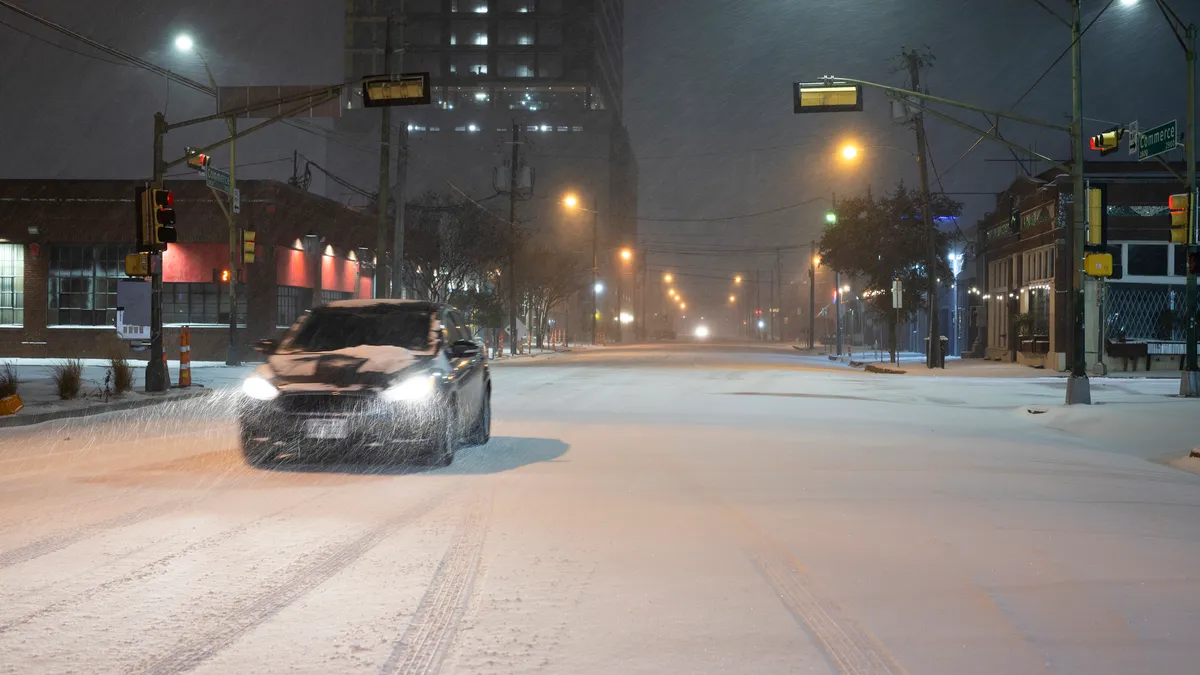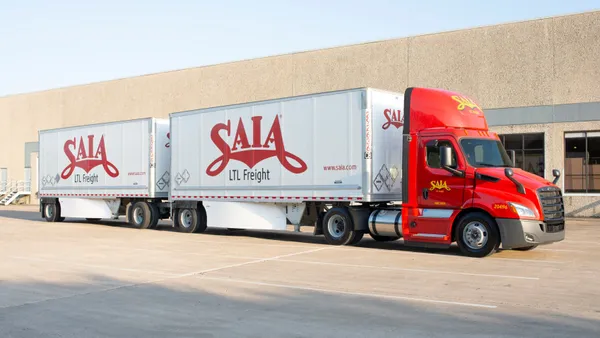Dive Brief:
- "Stocks were running down," at grocery stores across Texas, Gov. Greg Abbott said at a news conference Thursday, as winter storms crippled the state and left millions without power and under boil-water advisories.
- H-E-B noted "severe disruption in the food supply chain" in a Friday morning update. "For H-E-B, this means temporary impacts to manufacturing, warehousing [and] store operations." The grocery retailer placed limits on some items and halted curbside pickup and home delivery.
- The storm is also delaying cross-border shipments. Laredo, Texas, crossings that typically take one day are taking two or three days, said Deepak Chhugani, CEO of Nuvocargo, a digital freight forwarder and customs broker for U.S.-Mexico trade. "All industries are being affected by the situation, however, due to the time-sensitive nature of the products, perishables could suffer more than other industries due to delays," he said in an email.
Dive Insight:
The storm's impact is all too familiar to the problems food supply chain managers faced less than a year ago at the start of the pandemic when panic-buying ensued.
Texas Agriculture Commissioner Sid Miller issued a red alert about the food supply chain earlier this week. Miller said grocery retailers are unable to get dairy product shipments, but upstream, farmers are dumping milk because processing plants did not have power.
"We're looking at a food supply chain problem like we’ve never seen before, even with COVID-19," Miller said.
Grocery store stockouts are a common sight, with local media, lawmakers and residents posting photos to social media of empty shelves and long lines outside stores. H-E-B said some stores are experiencing low inventory of grocery bags and encouraged customers to bring their own. Grocers typically maintain lean inventories and just-in-time supply chains, making the industry prone to stock issues when demand suddenly changes.
"One thing that will aid in replenishing those stocks is the fact that the roads are more passable," Abbott said Thursday, referring to stock levels at grocery stores.
But even with road conditions improving, logistics managers may find challenges encountering capacity — and delayed shipments when they do find it.
Trucking capacity has been tight for months as the industry struggles with an ongoing driver shortage coupled with rising e-commerce freight demand. When the storms hit, transport firms idled trucks and shuttered service centers as roads closed and driving conditions became unsafe.
Demand rose (and so did spot rates) last week in anticipation of the storm. Load-to-truck ratios were up 29% over the previous week for van and 28% for reefer, according to DAT.
The timing of the storm, coming just after the Lunar New Year and Presidents Day weekend, also contributes to capacity challenges.
"This really has become the perfect storm of capacity," Drew Herpich, chief commercial officer of Nolan Transportation Group, said in a LinkedIn post. "It's giving freight brokers trouble across the nation."
Chhugani said Nuvocargo is communicating with carriers to understand their capacity and to find equipment, such as tires and chains, that can handle snowy and icy conditions.
"Though slower, freight has not stopped moving," Chhugani said.
Texas and the southeastern U.S. are no stranger to storms, though typically they're tropical storms and hurricanes in the summer and fall rather than ice storms in February. Supply chains in the region prepare months ahead of time for hurricanes by repositioning inventory, and fleets typically ramp up preventive maintenance in the spring. The unprecedented storms of this week left little time for preparation and planning.
As of Friday morning, much of southern Texas and Louisiana were under a hard freeze warning, but the National Weather Service said the central and southern plains will begin to thaw out this weekend.
Johnathan Foster, principal consultant at Proxima, expects supply chain disruptions to continue for at least a couple of weeks. He anticipates consumers will return to grocery stores once snow and ice clears to procure items they could not get at the height of the storm. And that will create another surge in the carrier market, straining capacity and spiking rates.
"As a rule of thumb, it will take 3 times the rate of the shutdown to recover fully," Foster said.














